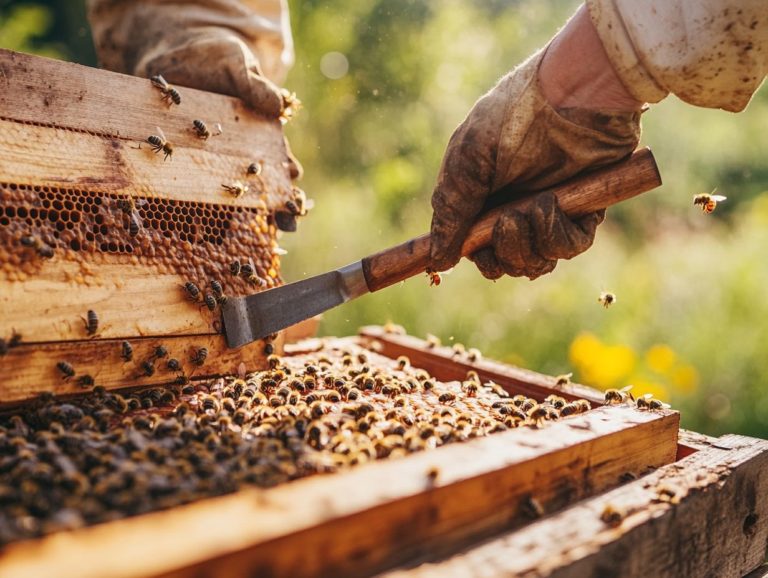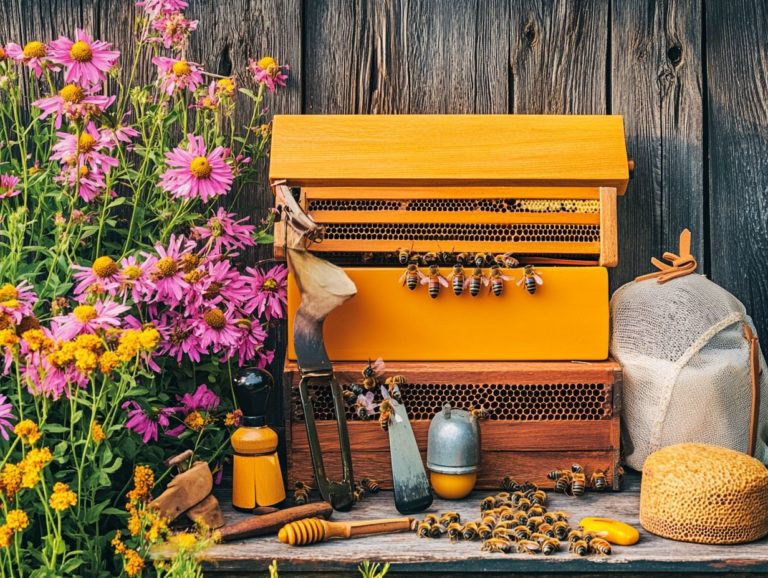Best Honey Extractors for Home Beekeepers
Choosing the right honey extractor from brands like Civan, Vevor, or Dadant & Sons can truly elevate your beekeeping experience and guarantee a fruitful honey harvest.
Whether you’re a seasoned beekeeper or just starting out, understanding the different types of extractors is vital. These include manual, electric, radial, and tangential models.
This guide helps you navigate the world of honey extractors. You ll learn about materials, sizes, cleaning ease, and budget considerations.
Explore the benefits and pitfalls of honey extractors. Find maintenance tips to choose the perfect extractor for your needs and boost your honey production.
Consider aspects like honey gate design, honey spinner efficiency, and the impact of honey mist during extraction.
Contents
- Key Takeaways:
- 1. Manual Honey Extractors
- 2. Electric Honey Extractors
- 3. Radial vs Tangential Honey Extractors
- 4. Stainless Steel vs Plastic Honey Extractors
- 5. Top-Bar vs Frame Honey Extractors
- 6. Size and Capacity of Honey Extractors
- 7. Ease of Cleaning and Maintenance
- 8. Price and Budget
- 9. Brand Reputation and Customer Reviews
- 10. Features and Accessories
- What Is a Honey Extractor and How Does It Work?
- Benefits of Using a Honey Extractor
- What Are the Different Types of Honey Extractors Available?
- How Can a Beekeeper Determine the Right Honey Extractor for Their Needs?
- What Are the Common Mistakes to Avoid When Using a Honey Extractor?
- How Can a Beekeeper Properly Maintain and Clean Their Honey Extractor?
- Frequently Asked Questions
- What are the best features to look for in a honey extractor for home beekeepers?
- Are manual or electric honey extractors better for home beekeepers?
- What size of honey extractor is best for home beekeepers?
- Do honey extractors come with a warranty?
- What is the average price range for honey extractors for home beekeepers?
- Can honey extractors be used for other purposes besides extracting honey?
Key Takeaways:
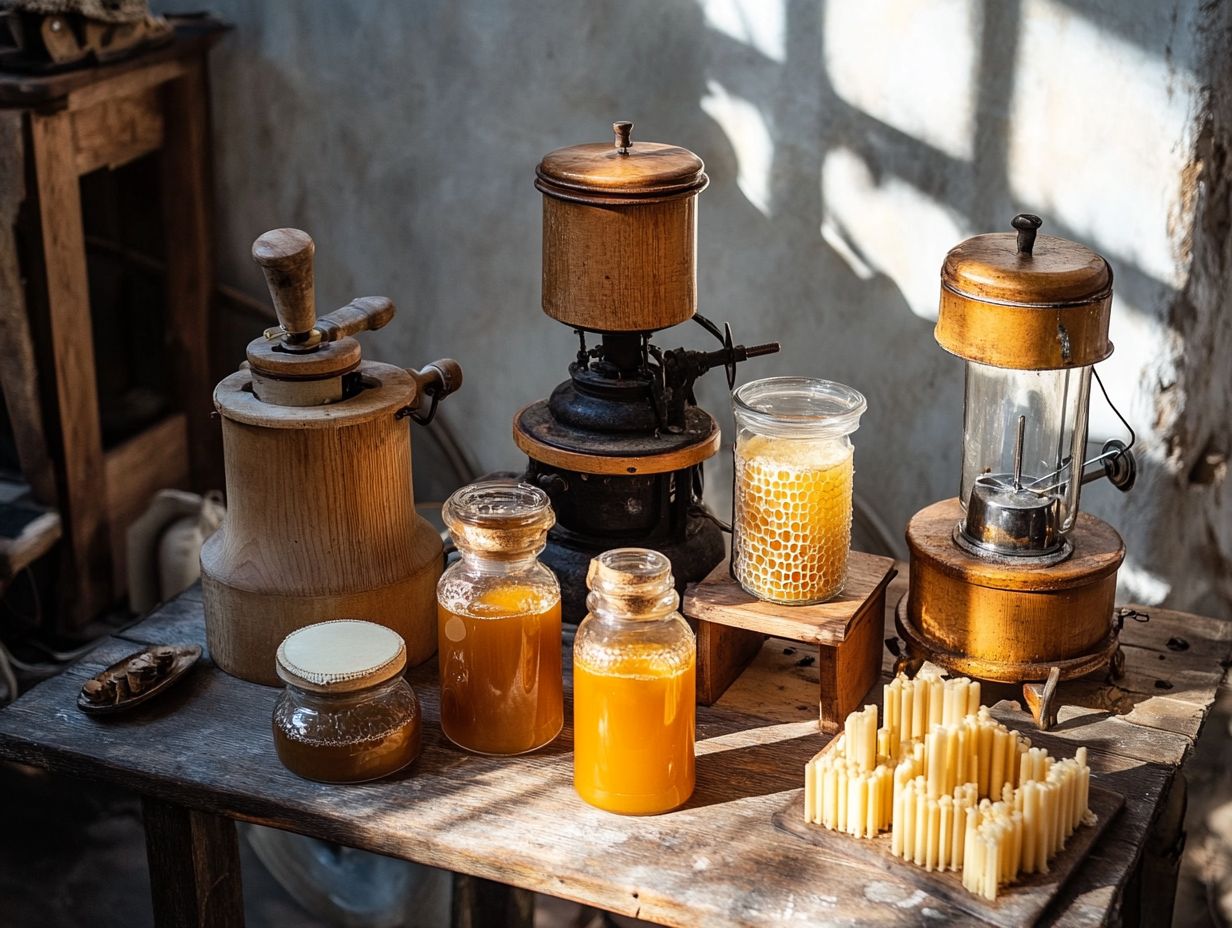
- Choose an electric honey extractor for ease of use and faster extraction. Electric motors and speed control features can significantly enhance your extraction process.
- Consider the size and capacity of the honey extractor to match your beekeeping needs.
- Regular cleaning and maintenance is essential for prolonging the lifespan of your honey extractor. Make sure to use food-safe lubricant for optimal performance and smooth operation.
1. Manual Honey Extractors
Manual honey extractors are essential tools for beekeepers like you, allowing for the efficient extraction of honey from honeycomb without causing harm to those delicate frames. These hand crank models are ideal for affordable beekeeping. Many beekeeping clubs recommend starting with a manual extractor to understand the basics of honey extraction.
With a hand crank mechanism at your disposal, you can control the speed of the honey extraction process, which is essential for maximizing your honey yield while protecting the integrity of the uncapping frames and honeycomb cells. A clean honey extractor ensures the liquid honey remains free from contaminants.
These extractors come in various sizes, perfectly designed to accommodate deep, medium, and shallow frames, offering you the versatility needed for different hive configurations. This type of beekeeping equipment is crucial for efficient hive management. Unlike electric models, which can sometimes sacrifice control over extraction speed and risk damaging the comb, manual extractors provide a gentler approach that you can easily tailor to your specific needs.
During the honey harvest, it s crucial to handle the frames with care. Gently transferring them in an optimal sequence will help you avoid unwanted crushing or bruising. Proper frame manipulation techniques are essential for maintaining the quality of your honey. Keeping your extractor clean is equally important to ensure that the honey maintains its quality, remaining free from any contaminants that could affect its flavor or purity.
If you re adventurous in your beekeeping journey, consider building a DIY honey extractor. It s a fun project that can be tailored to your needs! Many beekeeping clubs offer workshops on building your own extractor, which can be customized to suit your unique requirements.
2. Electric Honey Extractors
Electric honey extractors have transformed the honey extraction process, allowing you to harvest honey with remarkable efficiency. These motorized extractors feature ball bearings for smooth operation and reduce both labor and time, maximizing your honey production.
Equipped with speed control, you can easily adjust the extraction speed to accommodate different types of honeycomb, whether it s from deep frames or shallow ones. This exciting new method simplifies the extraction process while keeping your honey at its best.
It s a game-changer for hobbyist beekeepers and large-scale honey producers alike. The ease of use is a significant perk; you can operate these extractors with minimal effort, allowing you to focus on other essential tasks within your apiary.
When selecting the right electric honey extractor, consider key factors: the scale of your beekeeping operation, compatibility with specific hive types, and your budget. Opting for models crafted from stainless steel guarantees long-lasting durability while ensuring hygiene. Choosing stainless steel protects your precious honey from contamination don t settle for less!
3. Radial vs Tangential Honey Extractors
When selecting a honey extractor, you ll often face a choice between radial and tangential options, each offering unique advantages for different extraction styles. Radial extractors allow honey to be extracted from both sides of the frame simultaneously, leading to faster harvests.
Conversely, tangential extractors extract honey from one side at a time, making them a fitting choice for smaller operations or beginners in honey extraction. Your choice will significantly impact the efficiency of your honey extraction based on your production scale.
If you re operating a larger apiary, a radial extractor is often the way to go, as it can handle multiple frames simultaneously, greatly enhancing productivity and cutting down processing time. These honey centrifuges also ensure high-quality liquid honey.
If you re a hobbyist or a small-scale beekeeper with a limited number of hives, a tangential extractor may be perfect for you. This type of manual extractor is affordable and user-friendly, making it ideal for those who value quality over sheer quantity. Ultimately, both types of extractors are essential for maximizing honey yield while meeting your operational needs.
4. Stainless Steel vs Plastic Honey Extractors
Choosing between stainless steel and plastic honey extractors is a crucial decision for beekeepers, as it influences both the quality of your honey and the durability of your equipment. Stainless steel extractors are preferred for their exceptional durability, ease of cleaning, and resistance to rust and corrosion. This makes them a favored choice among both hobbyist beekeepers and commercial honey producers.
However, plastic extractors might be appealing as a budget-friendly option, especially for newcomers to beekeeping. Each material has distinct advantages and disadvantages that may sway your decision.
Stainless steel is celebrated for its hygienic qualities; it doesn t harbor bacteria and is easy to sanitize, essential for maintaining honey quality. While the higher price tag may give you pause, the longevity of stainless steel often justifies the investment.
In contrast, plastic extractors are lightweight and more affordable but may not withstand the test of time as well as stainless steel options.
As you navigate this decision, evaluate your specific needs considering factors like your budget, how often you plan to use the extractor, and the quality of honey you desire. Product reviews can provide additional insight into the best options available, leading you to an informed choice that aligns with your beekeeping practices.
5. Top-Bar vs Frame Honey Extractors
In the world of honey extraction, it’s essential to understand the distinct roles that top-bar extractors and frame honey extractors (extractors that use standard frames from beehives) play. Each appeals to different preferences among beekeepers.
Natural beekeeping practices favor top-bar extractors for their gentler extraction process, which is ideal for maintaining the integrity of the comb. They allow for a smoother extraction process from top-bar hives, sparing you the hassle of complex frame manipulation.
On the other hand, traditional frame honey extractors cater to those using standard beehive frames, offering a robust solution for larger honey harvests. These extractors maximize honey yield and simplify hive management.
While both types of extractors ultimately serve the same purpose separating honey from the comb their efficiency can differ significantly depending on your specific context. Top-bar extractors truly shine in smaller operations where simplicity and minimal disturbance to the bees are paramount. If sustainability and organic practices are high on your priority list, this option may be the perfect fit for you. Imagine a smoother extraction process!
In contrast, frame extractors excel in commercial settings where high-volume honey production is the name of the game. They simplify the extraction process, making it quicker and more efficient, especially when dealing with established frames filled with various types of honeycomb. If you’re looking to maximize your honey yield while keeping the process manageable, frame extractors are undoubtedly worth considering.
6. Size and Capacity of Honey Extractors
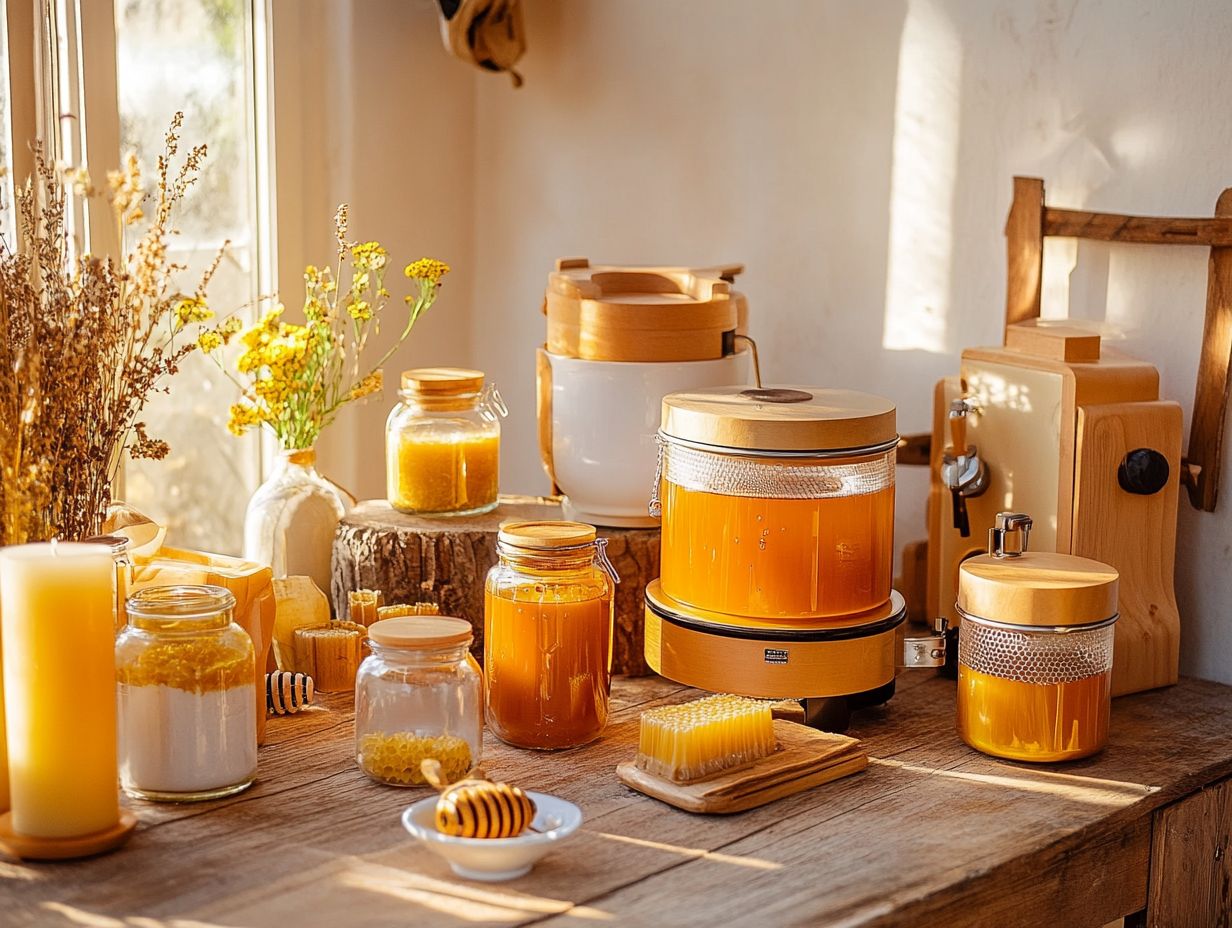
Selecting the right size and capacity for your honey extractor is crucial for optimizing honey production during the harvest. Frame baskets and honeycomb frames should be compatible with the extractor s design for efficient processing.
The efficiency of the extraction process hinges on the extractor’s design and its capability to handle specific volumes of honeycomb frames. Choose models with appropriate storage capacities that align with your production goals. Act now to find the perfect honey extractor for your needs!
If you re a hobbyist beekeeper with just a few hives, a smaller extractor might be your best bet. Conversely, if you’re in the business of honey production, larger, industrial-sized models are designed to accommodate multiple frame baskets, meeting the demands of a commercial operation.
As you explore the various honey extractor sizes available, consider the storage capacities and frame compatibility of each model. Take a moment to assess the scale of your operation; if you re managing only a handful of hives, a compact extractor that holds just a couple of frames at a time could be both practical and efficient.
If you have a higher volume of honey to process, opting for a larger extractor will enhance your efficiency, enabling you to maximize production without compromising on quality. Ultimately, choosing the right extractor is about aligning your equipment with your specific production goals. Choose wisely to maximize your honey production this season!
7. Ease of Cleaning and Maintenance
Ensuring a clean honey extractor after each use is crucial for maintaining the quality of your honey. Regular maintenance and proper storage extend the lifespan of your beekeeping equipment.
When evaluating honey extractors and other beekeeping equipment, consider the ease of cleaning and maintenance. Proper upkeep not only extends the lifespan of your equipment but also ensures the purity and quality of the honey you produce. Stainless steel extractors are generally easier to clean than plastic ones, making them the preferred choice for beekeepers who prioritize cleanliness and want to prevent contamination of their liquid honey.
Establish routine cleaning practices for your beekeeping equipment. After each use, give your extractor a thorough rinse and apply food-grade lubricant, which is a safe lubricant that won’t harm your honey, to the moving parts for optimal performance. These straightforward yet effective maintenance habits protect the machinery and ensure that no residual contaminants interfere with the quality of your honey during extraction.
Neglecting regular cleaning can lead to bacteria buildup, residual wax, and honey mist, compromising both the flavor and safety of your honey.
Poor maintenance can lead to problems with your extractor. This may require costly repairs or replacements, ultimately impacting the profitability of your honey production. Prioritizing maintenance is not just a practical choice; it’s an investment in the quality of your product and the success of your beekeeping endeavors and honey production.
8. Price and Budget
Understanding the price range and budget requirements for honey extractors is essential for you as a beekeeper. This knowledge enables you to make informed decisions that align with your financial capabilities while still securing quality equipment tailored to your needs. Manual extractors are often more affordable than electric ones, which usually boast advanced features like speed control and ball bearing mechanisms that justify their higher price tags.
Several factors influence the pricing of these tools, with material quality and beekeeping budget being significant determinants. For instance, stainless steel models tend to be more expensive than plastic alternatives due to their durability and longevity, making them a valuable addition to your beekeeping supply.
Brand reputation also plays a critical role; well-established manufacturers like Civan, Vevor, and Dadant & Sons often offer warranties and reliable performance, making a higher price worthwhile. Make sure to choose essential features that suit your needs, striking a balance between quality and your beekeeping budget.
Don t forget to explore affiliate links; they can lead you to purchasing options that fit not only your beekeeping needs but also your financial plan. Start comparing models today to find the best fit for your budget and needs!
9. Brand Reputation and Customer Reviews
Choose a honey extractor based on brand reputation and customer reviews for better reliability and performance. By focusing on trusted manufacturers like Civan, Vevor, and Dadant & Sons, you’re more likely to invest in quality craftsmanship that enhances your overall honey extraction experience.
Understanding how a brand s reputation is built through consistent positive feedback and product reviews helps identify which models are favored by seasoned beekeepers. A strong history of customer testimonials provides peace of mind, illuminating not just the product’s functionality but also the level of support and service you can expect from the manufacturer after your purchase.
Take the time to conduct thorough research explore online forums, product reviews, and manufacturer websites to ensure you’re making well-informed decisions. By evaluating these factors, you can feel confident in your choice, leading to a more successful and rewarding investment in your honey extraction process.
10. Features and Accessories
Explore the world of honey extractors, where additional features and accessories can enhance your extraction experience. Options like honey gates allow for easy dispensing, while frame baskets help with frame handling.
Look for adjustable speed controls tailored to your honey extraction needs. Many extractors include automatic temperature controls and integrated filtering systems to maintain honey quality throughout the process.
You may also want accessories like honey jars with measuring indicators and cleaning brushes designed for your extractor. This ensures your extractor remains in top shape.
These enhancements streamline operations and keep your honey pure and free from impurities. Ergonomic features, such as handles and transport wheels, make it easier to handle heavy equipment.
What Is a Honey Extractor and How Does It Work?
A honey extractor is an essential tool for beekeepers. It efficiently extracts liquid honey from honeycomb while preserving its structure, which is vital for honey production and hive health.
The extractor uses centrifugal force to spin honeycomb frames. This allows honey to flow freely without harming the hive.
Typically, a honey extractor has a durable metal or plastic drum with a motor to spin wire or wooden frames filled with honeycomb. Inside, there are perforated honey collection baskets to let honey drain into a bottom reservoir.
During operation, the combs are held securely. As the drum spins, honey clings to the walls and gravity pulls it into the collection area.
This method maximizes your honey harvest while keeping bees safe. Reliable extractors are vital for sustainable beekeeping and lead to healthier hives.
Benefits of Using a Honey Extractor
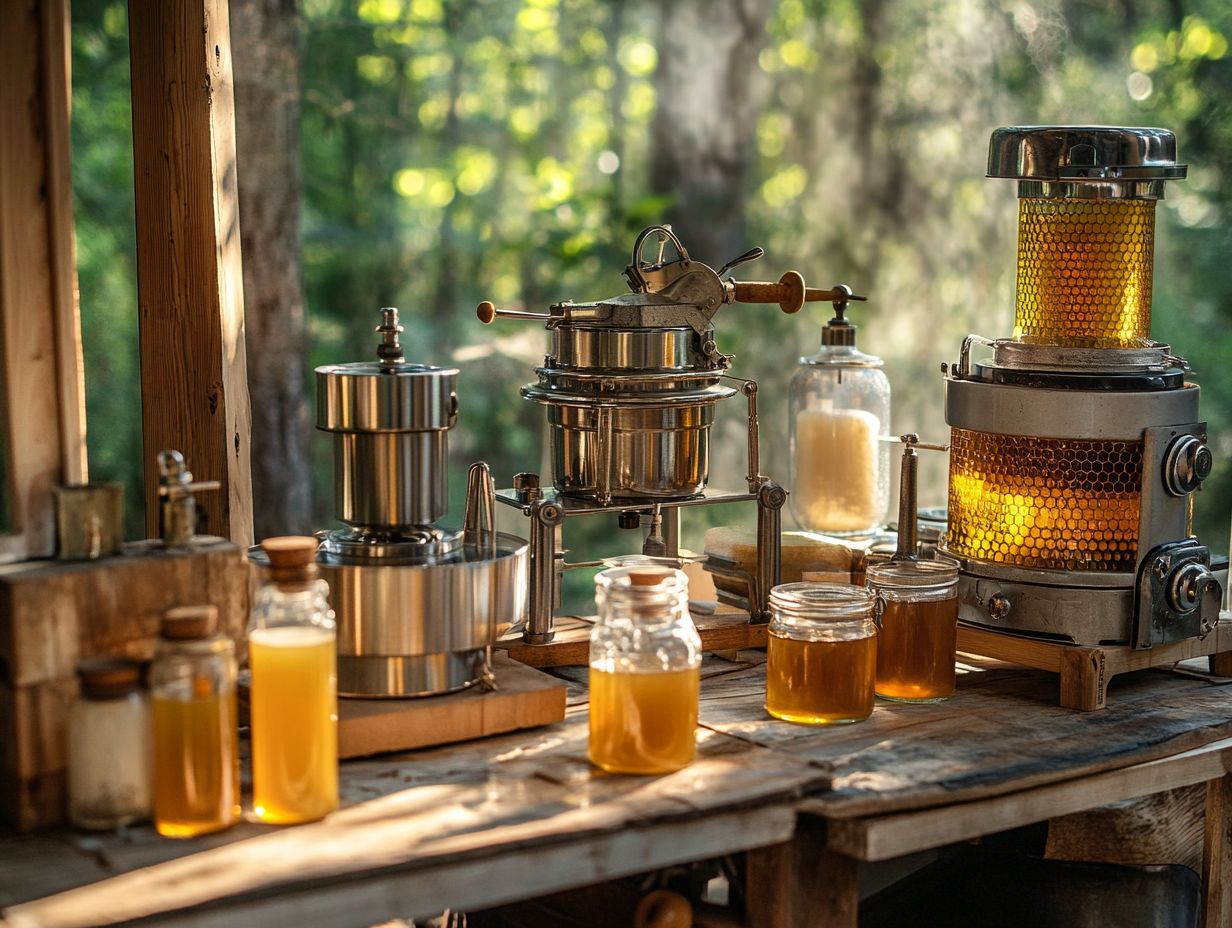
Using a honey extractor offers numerous benefits that improve honey production efficiency. It’s an invaluable tool for both amateur and experienced beekeepers.
One significant advantage is the ability to harvest honey without damaging honeycomb. This not only boosts future yields but also supports the long-term health of your hive.
This careful approach preserves honeycomb integrity and results in superior quality honey that retains its natural flavor and nutritional value.
Honey extractors save you time and effort during harvesting, allowing you to manage your hives better and focus on tasks like uncapping frames.
Whether for hobby or business, honey extractors meet various needs, enhancing productivity and sustainability in honey production.
What Are the Different Types of Honey Extractors Available?
Honey extractors come in a range of types, each crafted to cater to specific extraction needs and preferences, including DIY honey extractors for those who enjoy hands-on projects. Whether you re considering manual extractors, electric options, radial extractors, or tangential extractors, understanding these differences is crucial for you as a beekeeper. It will help you select the right equipment that works well with how you want to harvest honey and the scale of your operations.
For example, manual extractors offer a cost-effective and straightforward solution, making them perfect for hobbyist beekeepers managing fewer hives with shallow frames, medium frames, or deep frames. This allows you to maintain control over the extraction speed, ensuring you get the most out of your honey. Electric honey extractors offer efficiency and speed, making them ideal for commercial operations where you regularly process larger quantities of honey, thanks to their electric motor.
In terms of radial and tangential models, radial extractors spin the frames around a central axis, extracting honey from both sides simultaneously, which can save you valuable time. In contrast, tangential extractors require you to flip the frames during extraction, leading to a bit more labor on your part. Each type of extractor has its unique advantages and limitations, so it’s essential for you to evaluate your specific needs carefully before making a decision, possibly by consulting beekeeping clubs and other community resources.
How Can a Beekeeper Determine the Right Honey Extractor for Their Needs?
Selecting the ideal honey extractor tailored to your beekeeping needs requires careful consideration of several key factors. You’ll want to take into account the scale of your honey production, your budget, and any specific equipment requirements that align with your beekeeping practices. Assessing your operational size, the number of hives you manage, and your honey extraction goals will empower you to make a well-informed decision.
It’s crucial to evaluate the space you have available for both storage and operation, as well as how frequently you plan to harvest honey throughout the year. This information is key to finding the perfect extractor for your needs! Consider factors like honey extraction methods, the use of radial extractors or tangential extractors, and your beekeeping equipment.
Don’t overlook your beekeeping budget; if you’re a new beekeeper, starting with a more affordable option may be wise. On the other hand, experienced keepers might find that investing in advanced extractors or a motorized extractor that enhances efficiency and speed pays off in increased overall productivity.
What Are the Common Mistakes to Avoid When Using a Honey Extractor?
Both new and seasoned beekeepers can easily fall prey to common missteps with a honey extractor, which can detrimentally affect the extraction process and even jeopardize the quality of the honey. These mistakes often arise from improper frame manipulation, inadequate cleaning, and a lack of understanding of how the extraction process works. Familiarity with beekeeping terms and understanding different extraction styles can help mitigate these issues.
To steer clear of these pitfalls, it s essential for you to prioritize the right handling techniques. Always remove frames gently to avoid crushing the comb. Regular maintenance of your extraction equipment is also critical; worn parts can lead to inefficient extractions and even potential contamination. Make sure to handle honeycomb frames and deep frames with care, and ensure that your honey spinner and honey centrifuge are in good condition.
To get the best results, try these practices:
- Pre-heating the extractor to allow for a smoother honey flow
- Using the correct speed settings to minimize foam production
- Ensuring your frame baskets are properly aligned
By keeping these factors in mind, you can significantly enhance the overall efficiency of your honey extraction process and ensure the final product maintains its exquisite quality.
How Can a Beekeeper Properly Maintain and Clean Their Honey Extractor?
Proper maintenance and cleaning of your honey extractor are essential practices that ensure the longevity of your equipment and uphold the quality of the honey you extract. Neglecting these tasks can lead to contamination and a decline in operational efficiency.
Establish a regular cleaning schedule! Utilize food grade lubricant for moving parts and ensure all surfaces are sanitized after each use. Use a clean honey extractor to maintain hygiene.
Routine cleaning protects the integrity of your honey! After each extraction, carefully rinse the interior components with warm water. Scrub away any sticky residues with a non-abrasive brush. A mixture of vinegar and water works wonders as a natural cleaner, effectively eliminating lingering residues while maintaining food safety. Pay special attention to honeycomb cells to avoid any contamination.
Don t forget to thoroughly dry all metal parts to prevent rust and corrosion. By incorporating these practices into your routine, you can maintain the health of your bees, elevate the flavor of your honey, and extend the life of your extractors. Regular use of a honey gate helps maintain the quality of your liquid honey.
For more information on taking care of bee colonies and honey extractors for home use, check out our comprehensive guides and affiliate links provided below.
Frequently Asked Questions
What are the best features to look for in a honey extractor for home beekeepers?
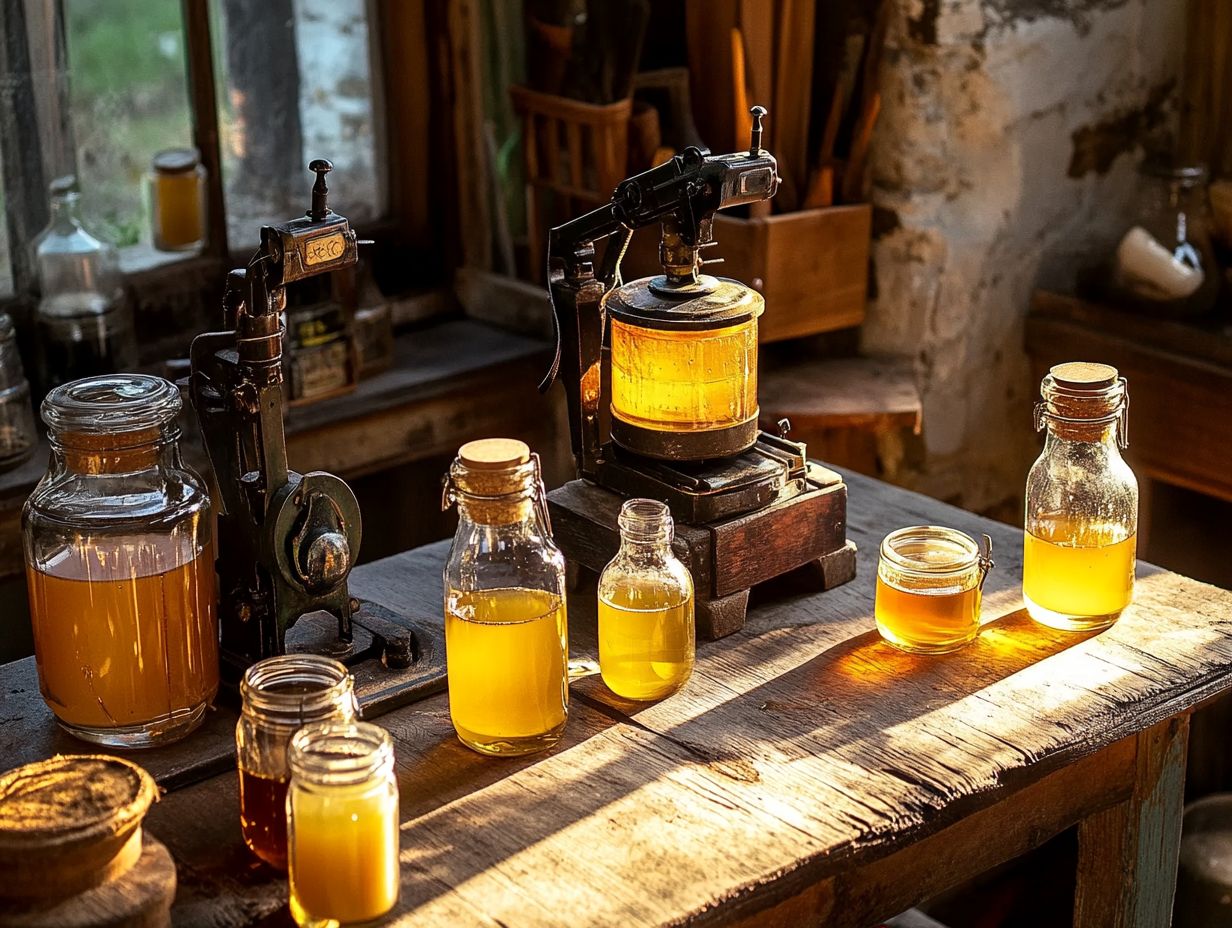
The best honey extractors for home beekeepers should have a durable and rust-resistant stainless steel construction, variable speed control, and compatibility with different frame sizes. They should also have easy-to-clean components and a sturdy base for stability.
Are manual or electric honey extractors better for home beekeepers?
Both manual and electric honey extractors have their advantages. Manual extractors, or hand crank extractors, are more affordable and suitable for small-scale beekeepers. Electric extractors are faster and require less physical effort. It ultimately depends on your preference and budget!
What size of honey extractor is best for home beekeepers?
The size of the honey extractor depends on the number of hives you have. For a small-scale beekeeper with 1-10 hives, a 2-frame or 4-frame extractor is sufficient. For larger operations, a 6-frame or 8-frame extractor is more suitable. Always consider your beekeeping needs when selecting an extractor. Also, think about whether you will use medium frames or shallow frames in your extraction process.
Do honey extractors come with a warranty?
Most reputable honey extractor brands, such as Civan, Vevor, and Dadant & Sons, offer a warranty for their products. Check the warranty period and coverage before making a purchase, as some warranties may only cover certain parts, while others cover the entire product.
What is the average price range for honey extractors for home beekeepers?
The price of honey extractors can range from $100 to $1000, depending on the type, size, and features. Manual extractors are generally more affordable, while electric extractors, with features like electric motors that speed up the extraction process and speed control that lets you adjust how fast the honey is spun, tend to be more expensive. Think about how long your honey extractor will last; a durable product is a smart investment.
Can honey extractors be used for other purposes besides extracting honey?
Yes! Honey extractors can be used to extract other types of sweet liquids, such as maple syrup and fruit juices. They are also great for extracting essential oils from herbs and plants. However, it s crucial to thoroughly clean the extractor between uses to avoid cross-contamination. Join beekeeping clubs and forums to connect with others who share tips and product reviews.
Invest in a quality honey extractor today and enjoy the sweet rewards of your beekeeping!

